
- 資料結構與演算法
- DSA - 首頁
- DSA - 概述
- DSA - 環境設定
- DSA - 演算法基礎
- DSA - 漸進分析
- 資料結構
- DSA - 資料結構基礎
- DSA - 資料結構和型別
- DSA - 陣列資料結構
- 連結串列
- DSA - 連結串列資料結構
- DSA - 雙向連結串列資料結構
- DSA - 迴圈連結串列資料結構
- 棧與佇列
- DSA - 棧資料結構
- DSA - 表示式解析
- DSA - 佇列資料結構
- 搜尋演算法
- DSA - 搜尋演算法
- DSA - 線性搜尋演算法
- DSA - 二分搜尋演算法
- DSA - 插值搜尋
- DSA - 跳躍搜尋演算法
- DSA - 指數搜尋
- DSA - 斐波那契搜尋
- DSA - 子列表搜尋
- DSA - 雜湊表
- 排序演算法
- DSA - 排序演算法
- DSA - 氣泡排序演算法
- DSA - 插入排序演算法
- DSA - 選擇排序演算法
- DSA - 歸併排序演算法
- DSA - 希爾排序演算法
- DSA - 堆排序
- DSA - 桶排序演算法
- DSA - 計數排序演算法
- DSA - 基數排序演算法
- DSA - 快速排序演算法
- 圖資料結構
- DSA - 圖資料結構
- DSA - 深度優先遍歷
- DSA - 廣度優先遍歷
- DSA - 生成樹
- 樹資料結構
- DSA - 樹資料結構
- DSA - 樹的遍歷
- DSA - 二叉搜尋樹
- DSA - AVL樹
- DSA - 紅黑樹
- DSA - B樹
- DSA - B+樹
- DSA - 伸展樹
- DSA - 字典樹
- DSA - 堆資料結構
- 遞迴
- DSA - 遞迴演算法
- DSA - 使用遞迴實現漢諾塔
- DSA - 使用遞迴實現斐波那契數列
- 分治法
- DSA - 分治法
- DSA - 最大-最小問題
- DSA - Strassen矩陣乘法
- DSA - Karatsuba演算法
- 貪心演算法
- DSA - 貪心演算法
- DSA - 旅行商問題(貪心演算法)
- DSA - Prim最小生成樹
- DSA - Kruskal最小生成樹
- DSA - Dijkstra最短路徑演算法
- DSA - 地圖著色演算法
- DSA - 分數揹包問題
- DSA - 帶截止日期的作業排序
- DSA - 最佳合併模式演算法
- 動態規劃
- DSA - 動態規劃
- DSA - 矩陣鏈乘法
- DSA - Floyd-Warshall演算法
- DSA - 0-1揹包問題
- DSA - 最長公共子序列演算法
- DSA - 旅行商問題(動態規劃)
- 近似演算法
- DSA - 近似演算法
- DSA - 頂點覆蓋演算法
- DSA - 集合覆蓋問題
- DSA - 旅行商問題(近似演算法)
- 隨機演算法
- DSA - 隨機演算法
- DSA - 隨機快速排序演算法
- DSA - Karger最小割演算法
- DSA - Fisher-Yates洗牌演算法
- DSA有用資源
- DSA - 問答
- DSA - 快速指南
- DSA - 有用資源
- DSA - 討論
指數搜尋演算法
指數搜尋演算法的目標是在輸入陣列的某個範圍內進行搜尋,它假設所需元素必須存在於該範圍內,並在該特定的小範圍內執行二分搜尋。該演算法也稱為倍增搜尋或手指搜尋。
它類似於跳躍搜尋,將排序後的輸入劃分為多個塊並進行更小規模的搜尋。但是,差異出現在計算劃分塊和應用的小規模搜尋型別時(跳躍搜尋應用線性搜尋,指數搜尋應用二分搜尋)。
因此,此演算法以 2 的冪進行指數跳躍。簡單來說,搜尋是在使用 pow(2, k) 分割的塊上執行的,其中 k 是一個大於或等於 0 的整數。一旦位置 pow(2, n) 處的元素大於鍵元素,則在當前塊上執行二分搜尋。
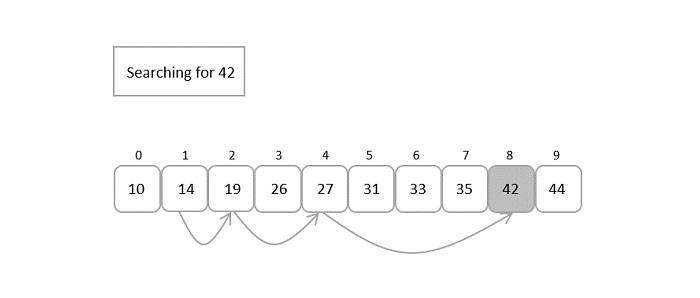
指數搜尋演算法
在指數搜尋演算法中,跳躍從陣列的第一個索引開始。因此,我們手動將第一個元素作為演算法的第一步進行比較。
步驟 1 − 將陣列中的第一個元素與鍵進行比較,如果找到匹配項,則返回第 0 個索引。
步驟 2 − 初始化 i = 1 並將陣列的第 i 個元素與要搜尋的鍵進行比較。如果匹配,則返回索引。
步驟 3 − 如果元素不匹配,則以 2 的冪對陣列進行指數跳躍。因此,現在演算法比較存在於增量位置的元素。
步驟 4 − 如果找到匹配項,則返回索引。否則,迭代地重複步驟 2,直到增量位置的元素大於要搜尋的鍵。
步驟 5 − 由於下一個增量具有比鍵更高的元素並且輸入已排序,因此演算法在當前塊上應用二分搜尋演算法。
步驟 6 − 如果找到匹配項,則返回鍵所在的索引;否則,將其確定為不成功的搜尋。
虛擬碼
Begin
m := pow(2, k) // m is the block size
start := 1
low := 0
high := size – 1 // size is the size of input
if array[0] == key
return 0
while array[m] <= key AND m < size do
start := start + 1
m := pow(2, start)
while low <= high do:
mid = low + (high - low) / 2
if array[mid] == x
return mid
if array[mid] < x
low = mid + 1
else
high = mid - 1
done
return invalid location
End
分析
儘管它被稱為指數搜尋,但它並非以指數時間複雜度執行搜尋。但眾所周知,在此搜尋演算法中,執行的基本搜尋是二分搜尋。因此,指數搜尋演算法的時間複雜度將與二分搜尋演算法相同,即O(log n)。
示例
為了更好地理解指數搜尋演算法並以更簡單的方式理解它,讓我們使用指數搜尋演算法在一個示例輸入陣列中搜索元素。
提供給搜尋演算法的排序輸入陣列為:

讓我們在給定陣列中搜索元素 81 的位置。
步驟 1
將陣列的第一個元素與鍵元素 81 進行比較。
陣列的第一個元素是 6,但要搜尋的鍵元素是 81;因此,跳躍從第 1 個索引開始,因為沒有找到匹配項。
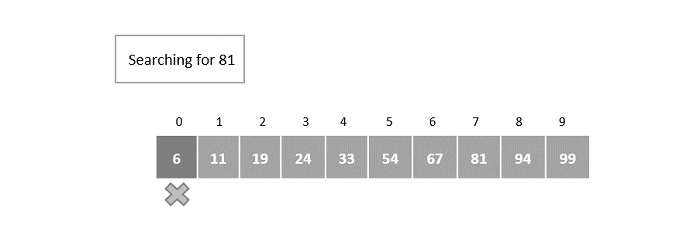
步驟 2
在初始化 i = 1 之後,將鍵元素與第一個索引中的元素進行比較。這裡,第一個索引中的元素與鍵元素不匹配。因此,它再次以 2 的冪進行指數遞增。
索引遞增到 2m = 21 = 將第二個索引中的元素與鍵元素進行比較。
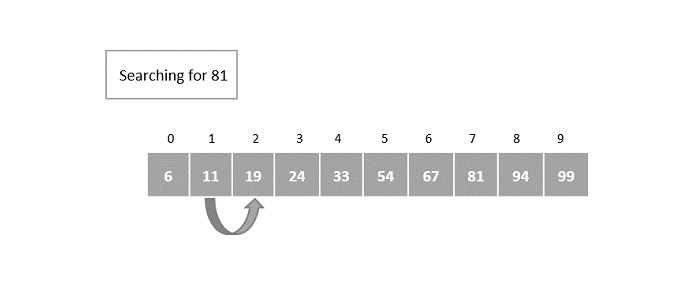
它仍然不匹配,因此再次遞增。
步驟 3
索引再次以 2 的冪遞增。
22 = 4 = 將第 4 個索引中的元素與鍵元素進行比較,但尚未找到匹配項。
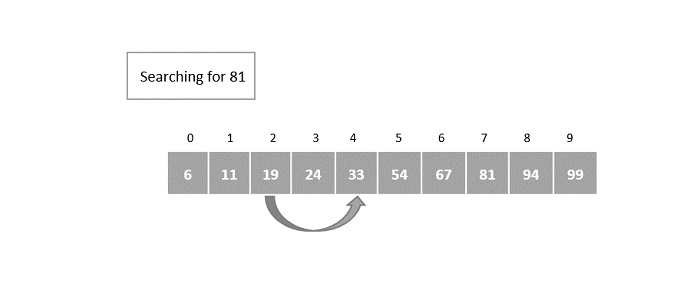
步驟 4
索引再次以指數方式遞增。這次將第 8 個索引中的元素與鍵元素進行比較,但沒有找到匹配項。
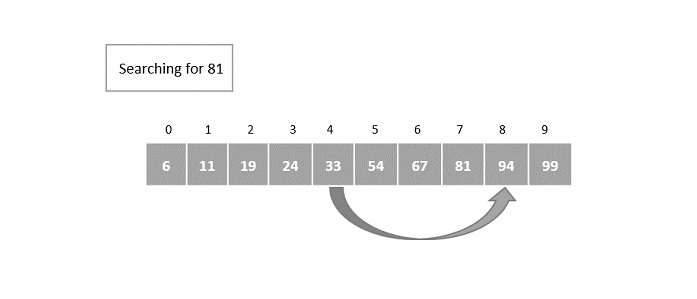
但是,第 8 個索引中的元素大於鍵元素。因此,在當前元素塊上應用二分搜尋演算法。
步驟 5
當前元素塊包含索引 [4, 5, 6, 7] 中的元素。
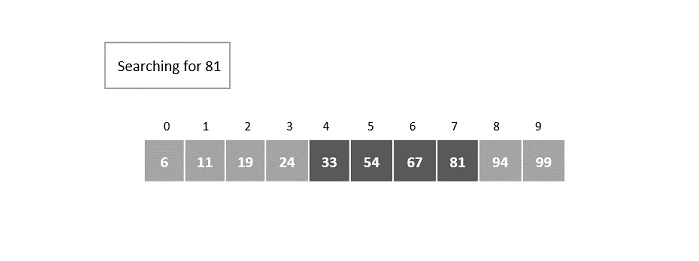
在此元素塊上應用小規模二分搜尋,其中計算出的中間值為第 5 個元素。
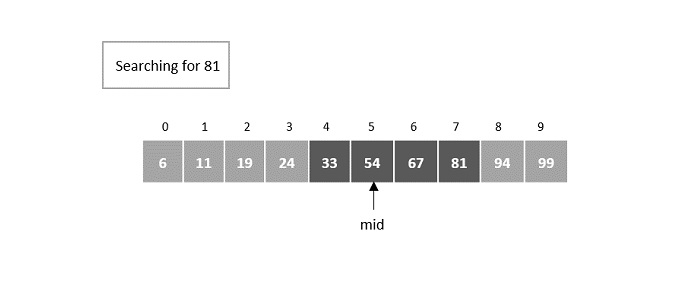
步驟 6
在中間元素處未找到匹配項,並發現所需元素大於中間元素。因此,搜尋發生在塊的右半部分。
現在將中間值設定為第 6 個元素:
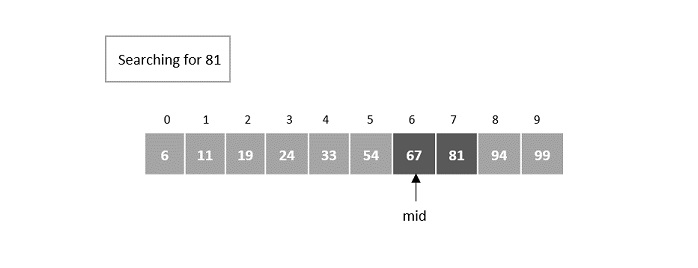
步驟 7
在第 6 個元素處仍然未找到元素,因此它現在搜尋中間元素的右半部分。
下一個中間值設定為第 7 個元素。
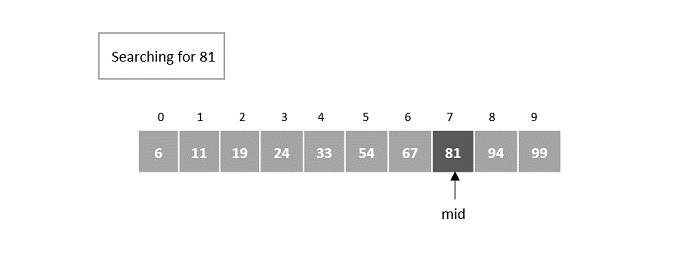
在這裡,在第 7 個索引處找到了該元素。
實現
在指數搜尋演算法的實現中,程式檢查每次以 2 的冪進行指數跳躍時的匹配項。如果找到匹配項,則返回元素的位置,否則程式返回不成功的搜尋。
一旦指數跳躍處的元素大於鍵元素,則在當前元素塊上執行二分搜尋。
在本章中,我們將研究四種不同語言中指數搜尋的實現。
#include <stdio.h>
#include <math.h>
int exponential_search(int[], int, int);
int main(){
int i, n, key, pos;
int arr[10] = {6, 11, 19, 24, 33, 54, 67, 81, 94, 99};
n = 10;
printf("Array elements are: ");
int len = sizeof(arr) / sizeof(arr[0]);
for(int j = 0; j<len; j++){
printf("%d ", arr[j]);
}
key = 67;
printf("\nThe element to be searched: %d", key);
pos = exponential_search(arr, n, key);
if(pos >= 0)
printf("\nThe element is found at %d", pos);
else
printf("\nUnsuccessful Search");
}
int exponential_search(int a[], int n, int key){
int i, m, low = 0, high = n - 1, mid;
i = 1;
m = pow(2,i);
if(a[0] == key)
return 0;
while(a[m] <= key && m < n) {
i++;
m = pow(2,i);
while (low <= high) {
mid = (low + high) / 2;
if(a[mid] == key)
return mid;
else if(a[mid] < key)
low = mid + 1;
else
high = mid - 1;
}
}
return -1;
}
輸出
Array elements are: 6 11 19 24 33 54 67 81 94 99 The element to be searched: 67 The element is found at 6
#include <iostream>
#include <cmath>
using namespace std;
int exponential_search(int[], int, int);
int main(){
int i, n, key, pos;
int arr[10] = {6, 11, 19, 24, 33, 54, 67, 81, 94, 99};
cout<<"Array elements are: ";
for(auto j : arr){
cout<<j<<" ";
}
n = 10;
key = 67;
cout<<"\nThe element to be searched: "<<key;
pos = exponential_search(arr, n, key);
if(pos >= 0)
cout << "\nThe element is found at " << pos;
else
cout << "\nUnsuccessful Search";
}
int exponential_search(int a[], int n, int key){
int i, m, low = 0, high = n - 1, mid;
i = 1;
m = pow(2,i);
if(a[0] == key)
return 0;
while(a[m] <= key && m < n) {
i++;
m = pow(2,i);
while (low <= high) {
mid = (low + high) / 2;
if(a[mid] == key)
return mid;
else if(a[mid] < key)
low = mid + 1;
else
high = mid - 1;
}
}
return -1;
}
輸出
Array elements are: 6 11 19 24 33 54 67 81 94 99 The element to be searched: 67 The element is found at 6
import java.io.*;
import java.util.Scanner;
import java.lang.Math;
public class ExponentialSearch {
public static void main(String args[]) {
int i, n, key;
int arr[] = {6, 11, 19, 24, 33, 54, 67, 81, 94, 99};
System.out.print("Array elements are: ");
for(int j = 0; j<arr.length; j++){
System.out.print(arr[j] + " ");
}
n = 10;
key = 67;
System.out.print("\nThe element to be searched: " + key);
int pos = exponential_search(arr, n, key);
if(pos >= 0)
System.out.print("\nThe element is found at " + pos);
else
System.out.print("\nUnsuccessful Search");
}
static int exponential_search(int a[], int n, int key) {
int i = 1;
int m = (int)Math.pow(2,i);
if(a[0] == key)
return 0;
while(a[m] <= key && m < n) {
i++;
m = (int)Math.pow(2,i);
int low = 0;
int high = n - 1;
while (low <= high) {
int mid = (low + high) / 2;
if(a[mid] == key)
return mid;
else if(a[mid] < key)
low = mid + 1;
else
high = mid - 1;
}
}
return -1;
}
}
輸出
Array elements are: 6 11 19 24 33 54 67 81 94 99 The element to be searched: 67 The element is found at 6
import math
def exponential_search(a, n, key):
i = 1
m = int(math.pow(2, i))
if(a[0] == key):
return 0
while(a[m] <= key and m < n):
i = i + 1
m = int(math.pow(2, i))
low = 0
high = n - 1
while (low <= high):
mid = (low + high) // 2
if(a[mid] == key):
return mid
elif(a[mid] < key):
low = mid + 1
else:
high = mid - 1
return -1
arr = [6, 11, 19, 24, 33, 54, 67, 81, 94, 99]
n = len(arr);
print("Array elements are: ")
for i in range(len(arr)):
print(arr[i], end = " ")
key = 67
print("\nThe element to be searched: ", key)
index = exponential_search(arr, n, key)
if(index >= 0):
print("The element is found at index: ", (index))
else:
print("\nUnsuccessful Search")
輸出
Array elements are: 6 11 19 24 33 54 67 81 94 99 The element to be searched: 67 The element is found at index: 6
